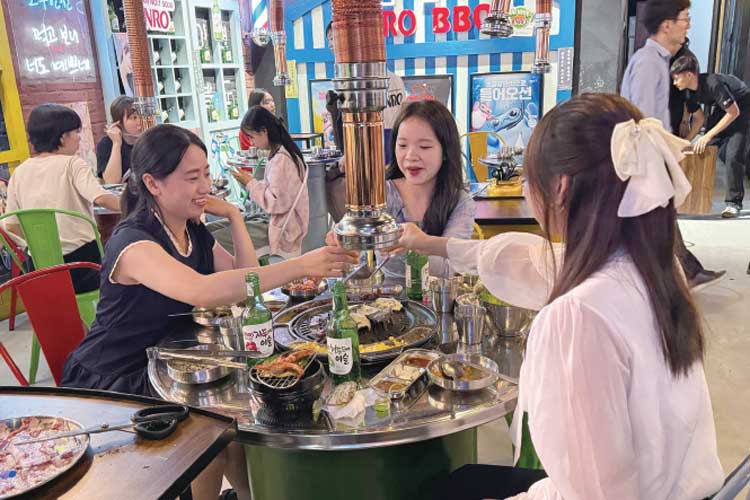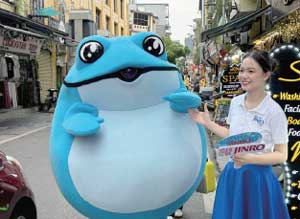
“It’s my friend’s birthday so we’re all gathered together to celebrate. We all like fruit soju so we’re drinking it, but I like it best when it’s served with meat.”
This is what college student Bu Thi Tam (21), whom we met at a restaurant near Ta Hien Beer Street in Hoan Kiem District, Hanoi, Vietnam, said on June 10. Tam was eating with friends at a restaurant selling Korean barbecue such as samgyeopsal, and drinking fruit soju such as Cheongpodo Eiseul. The way they were drinking soju while clinking glasses in the middle of the grill looked no different from Korean consumers.
Sweat said, "I was introduced to soju a few years ago by an acquaintance, and now I drink soju about twice a month." He also said, "My face gets red easily when I drink alcohol, but regular soju has a high alcohol content, but fruit soju has a low alcohol content, so I don't have to worry about that, which is good."
Even in the heat, a tasting and promotional event is held while wearing a ‘toad mask’
On Tahien Beer Street, it was not hard to find people enjoying fruit soju like sweat. Some people enjoyed fruit soju with salad or French fries instead of Korean food, and there were also people drinking it with Vietnamese noodles or rice dishes.
On the streets lined with numerous shops, various fruit-flavored sojus, from green grapes to peaches, strawberries, plums, and grapefruits, were placed on tables. The soju brand names, all written in Korean, and the signs written in Korean here and there created a Korean atmosphere even in the exotic Vietnamese streetscape.
“I drink a lot of soju in the US, so it’s interesting to see it in Vietnam,” said Yoo Da-young (22), a Korean-American who came to visit with friends in the US. “I like grape-flavored soju, and all my friends like it too.” Yoo visited Vietnam with two friends of different races.
Ta Hien Beer Street is a place where Hite Jinro is actively promoting entertainment channels to achieve its global strategy of ‘popularizing Jinro.’ This is because it is one of the representative tourist destinations visited by locals as well as 4 million foreign tourists who visit Hanoi every year.
On this day, despite the hot weather of nearly 30 degrees, people wearing toad masks, the symbol of Hite Jinro, were seen walking around Beer Street, offering tastings and promotional events. When you ordered soju at the store, they gave you fans, soju glasses, and dolls, and they even danced to music.
Cho Seong-gyun, head of Hite Jinro Vietnam, said, “Until recently, out of the 78 restaurants selling alcohol on this street, not a single one sold soju,” adding, “Now, 64 of them are selling soju as we are running promotional events along with sales.”
Hite Jinro plans to increase sales in the Vietnamese market through sales through entertainment channels.
Up until now, they have achieved success by focusing on sales through home channels, but with a 95% occupancy rate based on supermarkets, they have decided that attacking the entertainment market is essential for continued sales growth.
Hwang Jeong-ho, executive director of HiteJinro, also said, “In 2016, we started to target household channels through collaboration with distributors under the goal of globalizing soju, and most of our products are currently available through distributors,” and added, “Now is the time to shorten the product turnover cycle in household channels by targeting entertainment channels.” The idea is to expand the size of household channels by allowing more Vietnamese consumers to experience products in entertainment channels.
In fact, you can easily find Hite Jinro Soju products in supermarkets in Hanoi. At the Fuji Mart in Dong Da District, Hanoi, which has a high percentage of locals, you can even see a permanent display of Hite Jinro Soju products.

Localized prices due to local factory production
In addition to fruit soju products, they also sold regular soju products such as Chamisul and Jinro Is Back, and gift sets consisting of soju also caught the eye. Yoon Hyun-sik, team leader of Hite Jinro Vietnam, said, “Fuji Mart is a supermarket jointly operated by the Vietnamese BRG Group and the Japanese company Sumitomo, but Hite Jinro soju is available in all 11 stores.”
In addition to Hite Jinro products, Fuji Mart also stocked soju products from various companies. There were sojus made by Korean companies, such as Him Soju and Damso Soju made by Korea Apples, and Ara Soju made by Bohae Brewing, but there were also yogurt-flavored sojus and 40-proof liquors made by Thailand's TAWANDANG, sold in green bottles.
The soju in question was being sold for 46,500-61,500 dong (about 2,500-3,300 won), which is 230-1,030 won cheaper per bottle compared to Hite Jinro's product, which is being sold for 65,000 dong (about 3,530 won).
Team Leader Yoon explained, “Although our products are a bit more expensive than those of other companies, we are maintaining a high market share thanks to our brand power.” He added, “The Vietnamese soju market is not large, but we account for about 70% of the market.”
According to market research firm Euromonitor, soju’s share of the Vietnamese liquor market in terms of retail sales remained at 0.7% last year. Although the figure has increased slightly each year from 0.2% in 2019, it is still less than 1%.
However, the Vietnamese soju market continued to grow despite the slowdown in the liquor market growth last year. Last year, the Vietnamese liquor market size was 6.8796 trillion won, down 5% from the previous year, while the soju market increased by 14% to 49.1 billion won.
The size of Vietnam's soju market has been growing at an average annual rate of 44% from KRW 11.5 billion in 2019, and Euromonitor forecasts that it will grow at an average annual rate of 10% to KRW 72.8 billion by 2027. During the same period, the Vietnamese liquor market is estimated to grow to approximately KRW 10 trillion.
'JINRO' expands soju, builds local factories, localizes prices
Hite Jinro plans to localize its soju brand through a “Jinro popularization” strategy to promote the growth of the Vietnamese soju market and achieve a higher market share. The plan is to build a local production plant in the Thai Binh Special Economic Zone in Vietnam while making Jinro more widely known to consumers.
Executive Director Hwang said, “Up until now, we intended not to make any significant external differences with the various soju products on the Vietnamese market in order to promote the image that ‘green bottled liquor is soju. ’ Now, we plan to clearly position the Jinro brand so that consumers can recognize the brand.”
HiteJinro plans to expand Jinro Soju, currently sold in Japan, to the entire world in October. Unlike Chamisul or Jinro Is Back, Jinro Soju is characterized by the red letters “JINRO” on the product label.
In the long term, the company plans to accelerate its market penetration through a local factory in Vietnam. Starting in the second quarter of 2026, the company plans to produce 1 million cases (20 million bottles) of fruit soju annually at a local soju factory in Vietnam and supply it at a localized price.
Executive Director Hwang Jeong-ho said, “In the early days of soju exports, we sold it to foreign consumers who worked in Korea, but they did not buy it because it was more expensive than in Korea.” He continued, “Due to logistics costs and taxes, it can be chosen by consumers even if it is sold at 20,000 won per bottle, but it fundamentally has to match the exchange value that consumers think of.” He added, “The basic concept of overseas factories is to popularize Jinro while returning the benefits of local production to consumers,” and “Localizing product prices is something we have to do to expand the market.”